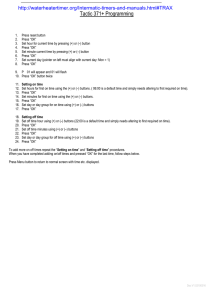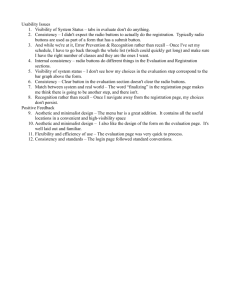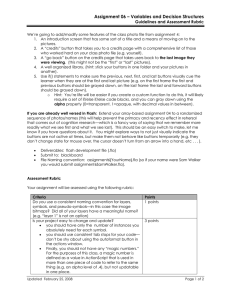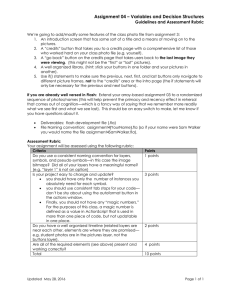Kindergarten Clarifying Lessons: Buttons, Buttons, Everywhere!
advertisement
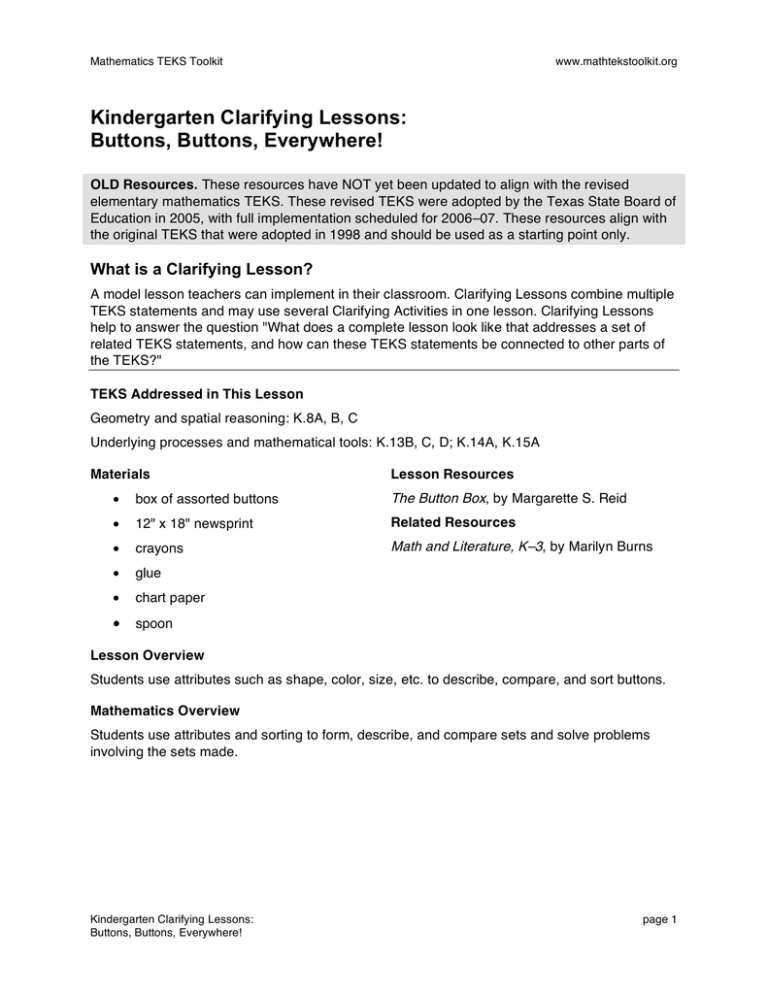
Mathematics TEKS Toolkit www.mathtekstoolkit.org Kindergarten Clarifying Lessons: Buttons, Buttons, Everywhere! OLD Resources. These resources have NOT yet been updated to align with the revised elementary mathematics TEKS. These revised TEKS were adopted by the Texas State Board of Education in 2005, with full implementation scheduled for 2006–07. These resources align with the original TEKS that were adopted in 1998 and should be used as a starting point only. What is a Clarifying Lesson? A model lesson teachers can implement in their classroom. Clarifying Lessons combine multiple TEKS statements and may use several Clarifying Activities in one lesson. Clarifying Lessons help to answer the question "What does a complete lesson look like that addresses a set of related TEKS statements, and how can these TEKS statements be connected to other parts of the TEKS?" TEKS Addressed in This Lesson Geometry and spatial reasoning: K.8A, B, C Underlying processes and mathematical tools: K.13B, C, D; K.14A, K.15A Materials Lesson Resources • box of assorted buttons The Button Box, by Margarette S. Reid • 12" x 18" newsprint Related Resources • crayons Math and Literature, K–3, by Marilyn Burns • glue • chart paper • spoon Lesson Overview Students use attributes such as shape, color, size, etc. to describe, compare, and sort buttons. Mathematics Overview Students use attributes and sorting to form, describe, and compare sets and solve problems involving the sets made. Kindergarten Clarifying Lessons: Buttons, Buttons, Everywhere! page 1 Mathematics TEKS Toolkit www.mathtekstoolkit.org Day One Set-up (to set the stage and motivate the students to participate) 1. Read The Button Box, by Margarette S. Reid. 2. Explain that the class is going to start a button collection. Ask each child to bring one button to school. (Send a note home if necessary, and bring extra buttons for students who forget or are unable to bring any from home.) Guiding Questions (to engage students in mathematical thinking during the lesson) • Is anyone wearing buttons today? (K.14A) • Who has a button collection at home? (K.14A) • How would you describe the container that holds your buttons? (K.8A, K.14A) • How would you describe some of the buttons that you have in your collection? (K.8A, B; K.14A) Teacher Notes (to personalize the lesson for your classroom) Day Two Set-up (to set the stage and motivate the students to participate) To begin the comparison of buttons, have students sit in a circle on the rug and put their buttons in front of them. Go around the circle, having each student state the color of his or her button. Repeat with other attributes such as size, shape, material, number of holes, etc. (K.8A, K.14A) Guiding Questions (to engage students in mathematical thinking during the lesson) • What words could you use to describe color? (K.8A, K.14A) • What words could you use to describe size? (K.8A, K.14A) • What words could you use to describe shape? (K.8A, K.14A) • What other ways could you describe this button? (e.g., number of holes) (K.8A, K.14A) Kindergarten Clarifying Lessons: Buttons, Buttons, Everywhere! page 2 Mathematics TEKS Toolkit www.mathtekstoolkit.org Teacher Notes (to personalize the lesson for your classroom) Summary Questions (to direct students' attention to the key mathematics in the lesson) In a whole class discussion, have students report what they noticed about their buttons: • What words (attributes) did you use to describe your buttons? (red, round, one-holed, etc.) (K.8A, K.14A) Teacher Notes (to personalize the lesson for your classroom) Assessment Task(s) (to identify the mathematics students have learned in the lesson) Collect all the buttons from the students by playing a game. Ask questions such as, "Button, button, who has a button that is not white?" and "Button, button, who has a button that is round?" Students who have buttons that fit the description deposit their buttons in a container. Continue until all the buttons have been collected. (K.8A, B; K.13D) Teacher Notes (to personalize the lesson for your classroom) Day Three Set-up (to set the stage and motivate the students to participate) Choose a student to act as your partner and model comparing your button with your partner's button. (e.g. Mine is round and yours is square, so they are different shapes; they are both red so they are the same color; etc.) Then, have students work in pairs to compare their buttons, taking turns telling something that is the same or different about their buttons. (K.8A, B; K.13B, C, D; K.14A; K.15) Guiding Questions (to engage students in mathematical thinking during the lesson) • What words could you use to describe this button? (K.8A, K.14A) • How are these two buttons different? (K.8A, B) Kindergarten Clarifying Lessons: Buttons, Buttons, Everywhere! page 3 Mathematics TEKS Toolkit • www.mathtekstoolkit.org How are these two buttons alike? (K.8A, B) Teacher Notes (to personalize the lesson for your classroom) Summary Questions (to direct students' attention to the key mathematics in the lesson) In a whole class discussion, have students report what they noticed about their buttons: • What words (attributes) did you use to describe your button? (red, round, one-holed, etc.) (K.8A) • How could your and your partner's buttons be alike? (same color, same shape, same number of holes, etc.) (K.8A, B; K.15) Teacher Notes (to personalize the lesson for your classroom) Assessment Task(s) (to identify the mathematics students have learned in the lesson) Tape a sheet of chart paper on the board and have the class gather on the rug. Tape two buttons next to each other at the top of the chart. Have students name things that are the same or different about the two buttons and record their responses on the chart. Teacher Notes (to personalize the lesson for your classroom) Day Four Set-up (to set the stage and motivate the students to participate) 1. Have students gather in a circle on the rug. Model sorting a set of buttons into two or more smaller sets according to an attribute such as shape and describing the sorting rule (e.g. These buttons are round, these buttons are long and skinny, these buttons are like triangles, etc.). Then model putting the set of buttons back together and sorting them according to another attribute, such as color. (K.8A, B, C) 2. Model for students a way to record their sorted sets, either by gluing the actual buttons on paper or drawing them in designated areas of folded paper. Have students dictate a Kindergarten Clarifying Lessons: Buttons, Buttons, Everywhere! page 4 Mathematics TEKS Toolkit www.mathtekstoolkit.org statement describing how the buttons were sorted. (The teacher can write their statement on the paper for them.) (K.13B, C, D; K.14A; K.15) 3. Give pairs of students a few spoonfuls of buttons (between 10 and 14 buttons). Have students work with their partners to sort the buttons and tell about how the buttons are sorted. Students should then put their buttons back together and re-sort them according to a different attribute and tell about it. (K.8A, B, C; K.13B, C, D; K.14A; K.15) Guiding Questions (to engage students in mathematical thinking during the lesson) • What is alike about these two buttons? What is different? (K.8A, B; K.15) • Are there other buttons like these? (K.8A, B, C; K.13B, C, D) • How did you sort your buttons? (K.14A, K.15) Teacher Notes (to personalize the lesson for your classroom) Summary Questions (to direct students' attention to the key mathematics in the lesson) • How did you sort your buttons? (K.14A, K.15) • Where would my button go in your groups? Why? (K.8A, B, C; K.15) • How else could you sort your buttons? (K.8A, B, C; K.13B, C, D) • How could you sort your buttons into just two groups? (K.8A, B, C; K.13B, C, D) Teacher Notes (to personalize the lesson for your classroom) Assessment Task(s) (to identify the mathematics students have learned in the lesson) • Have students choose one of ways they sorted their buttons to record as modeled. Help students write down what they want to say about the way their buttons were sorted. • Observe whether students were able to sort buttons by their attributes, articulate the attributes by which the buttons were sorted, record data about their buttons so that others could understand their sorting, and work cooperatively. Kindergarten Clarifying Lessons: Buttons, Buttons, Everywhere! page 5 Mathematics TEKS Toolkit www.mathtekstoolkit.org Teacher Notes (to personalize the lesson for your classroom) Extension(s) (to lead students to connect the mathematics learned to other situations, both within and outside the classroom) Place the button box, newsprint, crayons, and other items in a center so that students can continue the sorting activities. Post students' recording papers for discussions at later times. Teacher Notes (to personalize the lesson for your classroom) Kindergarten Clarifying Lessons: Buttons, Buttons, Everywhere! page 6


